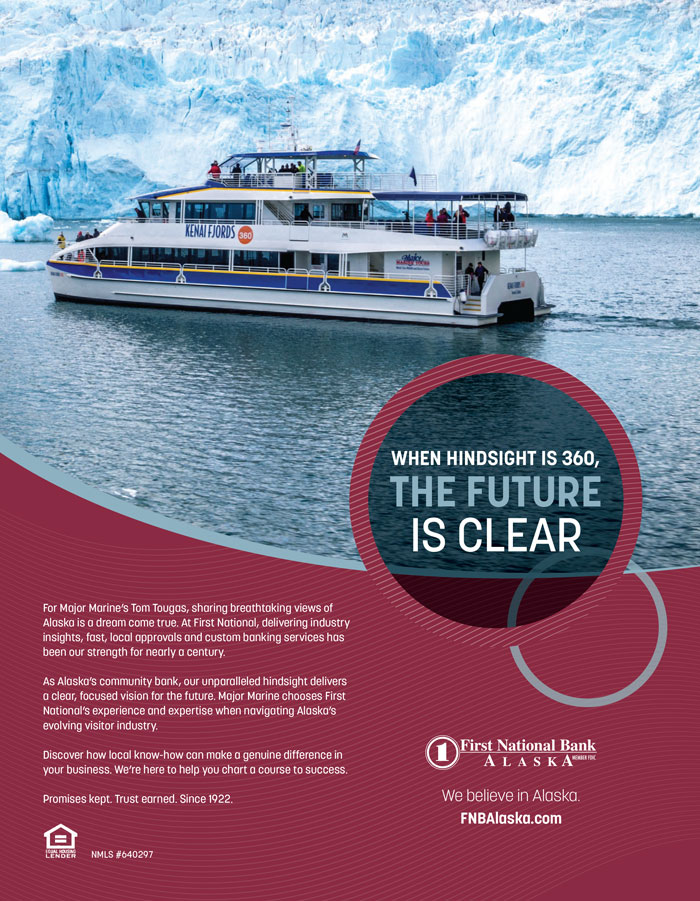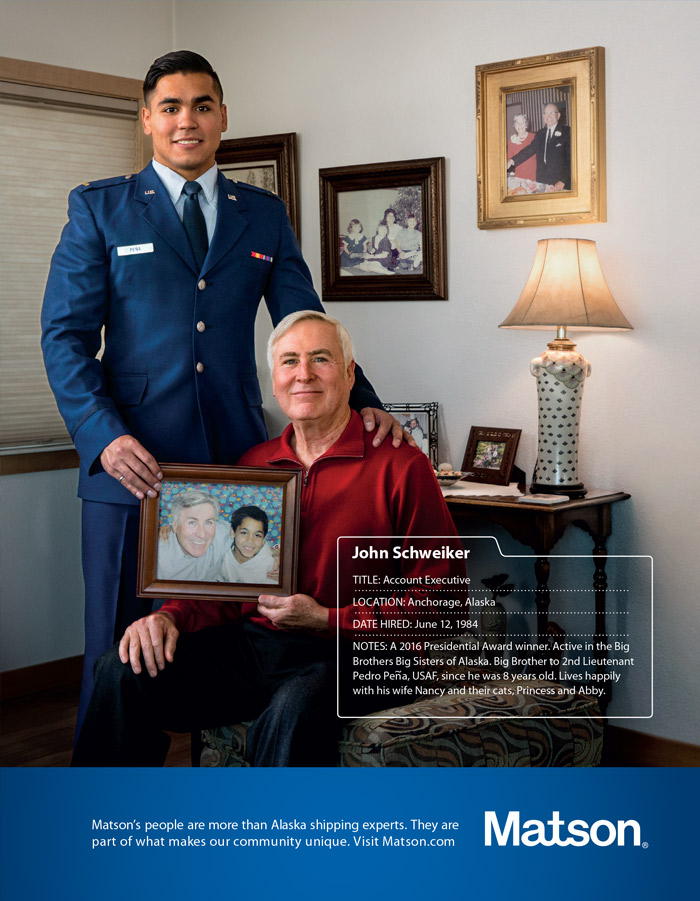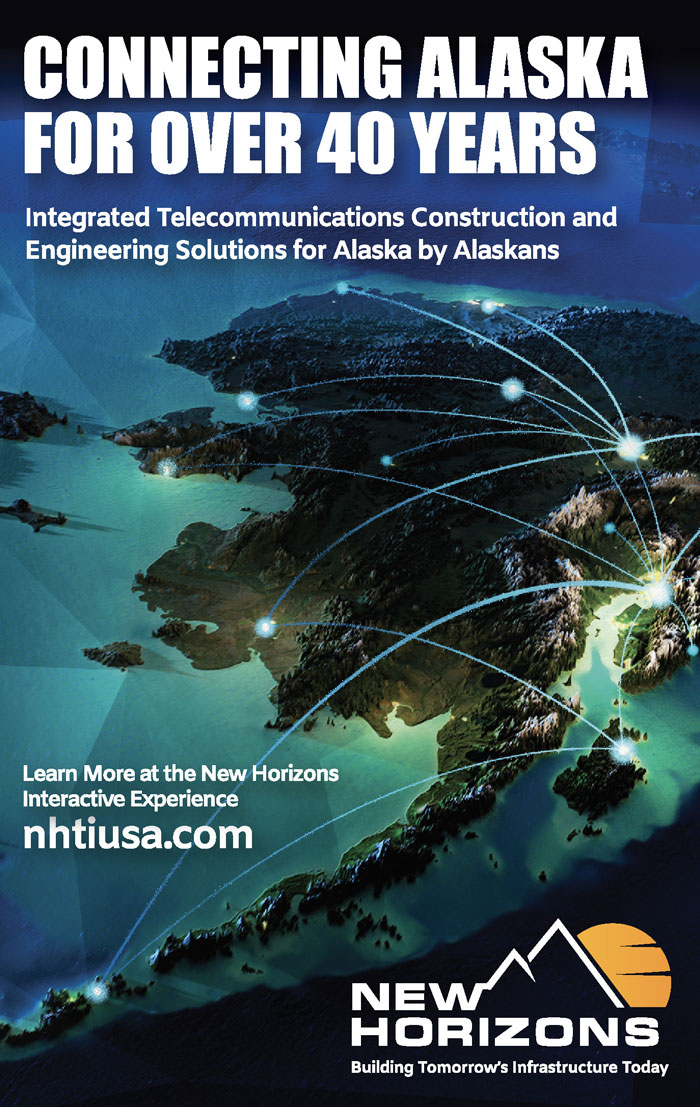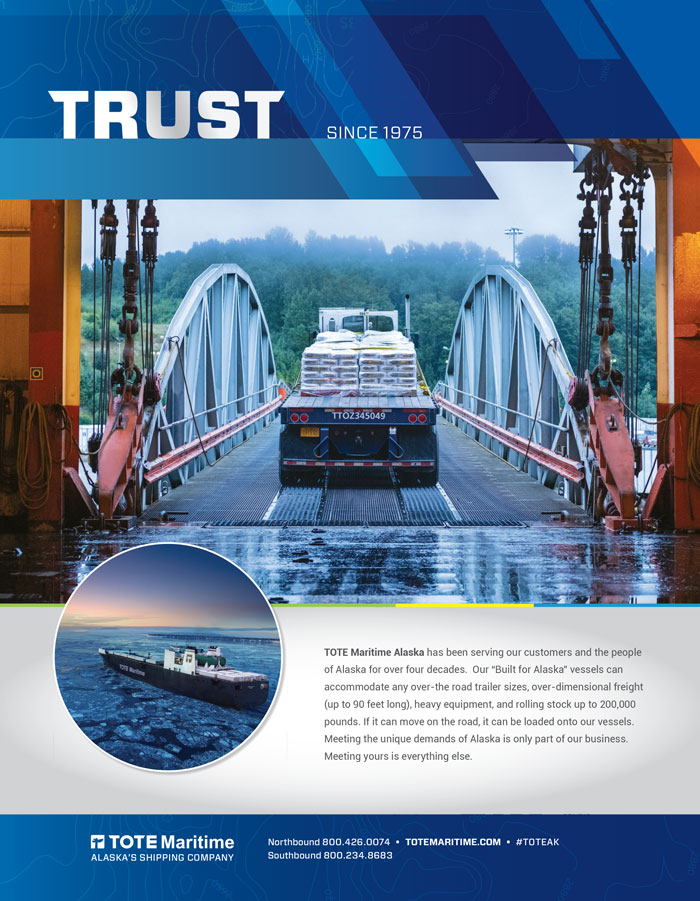Contents
Features

By Tracy Barbour

Arctic Infrastructure Ingenuity
By Vanessa Orr
New Methods of Tackling Old Problems
By Isaac Stone Simonelli
By Isaac Stone Simonelli
By Tasha Anderson

By Tracy Barbour

Arctic Infrastructure Ingenuity
By Vanessa Orr
New Methods of Tackling Old Problems
By Isaac Stone Simonelli
By Isaac Stone Simonelli
By Tasha Anderson
Transportation
Special Section
By Tasha Anderson
By Isaac Stone Simonelli
By Tasha Anderson
About The Cover
 Sailing the open seas has always carried risk, especially in the days before accurate navigational tools. The phrase “all at sea” stems from a time when, if a vessel wasn’t in sight of land, its position was uncertain and potentially lost.
Sailing the open seas has always carried risk, especially in the days before accurate navigational tools. The phrase “all at sea” stems from a time when, if a vessel wasn’t in sight of land, its position was uncertain and potentially lost.
The Alaska Marine Highway System’s future is certainly all at sea, but it doesn’t need to be. Much like ocean-travelers developed the tools to track their location and get them home safely, Alaska has all the tools it needs to point the ferry system in the right direction: managing costs, boosting efficiency, maintaining assets, and providing vital transportation services to Southeast and Southwest Alaska.
Departments
From the Editor
laskans talk about transportation a lot. And for good reason: getting around the state can be challenging and expensive. Ensuring all communities—small and large—have access to the goods and services they need is challenging and expensive. The good news is that there are many people and companies dedicated to transporting the goods and services needed to keep Alaska in business, in comfort, and in good health. The not-so-good news is that in recent years, Alaska’s infrastructure needs are not being met due to a lack of state funding. Perhaps most in peril at this point in time is the Alaska Marine Highway System, which is facing an uncertain future as state officials consider Governor Mike Dunleavy’s proposed $97 million in budget cuts designed to address a projected $1.6 billion shortfall, due to reduced revenue from the oil industry.
There are many points of contention related to Dunleavy’s budget, but what may be being missed is a much bigger question than whether these cuts are warranted. Is it possible that Alaska’s oil industry is shouldering too much of the responsibility when it comes to paying for infrastructure and crucial programs? The recession we are crawling out of has made it all too clear that when oil production or prices decline, so does the state’s ability to pay for essential services, such as the ferry system. Like many businesses have needed to do over the past few years, it’s time for Alaska’s officials to find ways to diversify its income.


Kathryn Mackenzie
Managing Editor, Alaska Business

Publishing Co. Anchorage, Alaska
Judy Patrick
Billie Martin
Toll Free: 1-800-770-4373
(907) 276-4373
www.akbizmag.com
Press releases: press@akbizmag.com
Alaska Business (ISSN 8756-4092) is published monthly by Alaska Business Publishing Co., Inc.,
501 W. Northern Lights Boulevard, Suite 100, Anchorage,
Alaska 99503-2577;
Telephone: (907) 276-4373;
© 2019 Alaska Business Publishing Co. All rights reserved. No part of this publication may be reproduced without written permission from the publisher. Alaska Business accepts no responsibility for unsolicited materials; they will not be returned unless accompanied by a stamped, self addressed envelope.
One-year subscription is $39.95 and includes twelve issues (print + digital) and the annual Power List. Single issues of the Power List are $15 each. Single issues of Alaska Business are $4.99 each; $5.99 for the July & October issues. Send subscription orders and address changes to circulation@akbizmag.com. To order back issues ($9.99 each including postage) visit simplecirc.com/back_issues/alaska-business.


hittier-based Phillips Cruises and Tours recently finished a two-year project to transform a former New York passenger ferry into a tourism excursion vessel for Alaska. The ferry had a complete retrofit: mechanics and electronics were replaced; new seating and tables were installed; and the interior cabin was opened up to give every seat a clear line of sight outside.
The Bravest—named after a New York Fire Department involved in a 9/11 rescue—made its long-awaited Alaska debut this spring. “The vessel we currently use for the 26 Glacier Cruise [the Klondike Express] has a capacity of 338 passengers, and this vessel will add another 288 seats,” says Bob Neumann, owner of Phillips Cruises and Tours. “So there will be less crowding at peak season. The biggest benefit is that we now have a backup vessel in case of engine failure or other issues with the Klondike Express.”
To facilitate revamping the Bravest, Neumann borrowed $7 million from First National Bank Alaska with a fixed interest rate of less than 5 percent and a twelve-year term. Half of those funds were used to pay off a higher-interest-rate loan from another institution, leaving $3.5 million for the retrofit. “Much of the project was done in house, where we used our own funds,” Neumann says.
NBBJ/©Benjamin Benschneider
s healthcare continues to evolve, so does the space where services are provided. While traditional visits to the doctor included seeing one practitioner in an exam room located in a stand-alone office, today’s office design may include “talking rooms,” shared space with other businesses, and an emphasis on access and convenience.
In many cases, former retail or commercial spaces have been converted into medical facilities.
“A lot of reasons why medical facilities are moving into retail locations revolve around convenience and access, particularly in urban areas,” explains Rich Dallam, managing partner at global architecture firm NBBJ and a leader of its health practice. “Taking time to drive back and forth to the doctor’s office is inconvenient; it’s easier for people if they can fit it into what they do in daily life, like going to the store or running errands.
“While many drug stores, such as CVS and Walgreens, have responded to consumer demand by venturing into ‘primary care lite,’ traditional providers are playing catch-up,” he continues. “These drug stores already have urgent care centers in retail spaces in many cities.”
According to Dallam, like most real estate transactions, location is key. “When we’re helping clients find a site, we look for places where there are already drug stores and Starbucks, because this is typically where people live and work,” he explains. “And not only is location important but so is the availability of the right kind of space.”
NBBJ/©Benjamin Benschneider
s healthcare continues to evolve, so does the space where services are provided. While traditional visits to the doctor included seeing one practitioner in an exam room located in a stand-alone office, today’s office design may include “talking rooms,” shared space with other businesses, and an emphasis on access and convenience.
In many cases, former retail or commercial spaces have been converted into medical facilities.
“A lot of reasons why medical facilities are moving into retail locations revolve around convenience and access, particularly in urban areas,” explains Rich Dallam, managing partner at global architecture firm NBBJ and a leader of its health practice. “Taking time to drive back and forth to the doctor’s office is inconvenient; it’s easier for people if they can fit it into what they do in daily life, like going to the store or running errands.
“While many drug stores, such as CVS and Walgreens, have responded to consumer demand by venturing into ‘primary care lite,’ traditional providers are playing catch-up,” he continues. “These drug stores already have urgent care centers in retail spaces in many cities.”
According to Dallam, like most real estate transactions, location is key. “When we’re helping clients find a site, we look for places where there are already drug stores and Starbucks, because this is typically where people live and work,” he explains. “And not only is location important but so is the availability of the right kind of space.”
Emerson
Emerson
ollowing the crash of oil prices in 2014, companies industry-wide started looking for ways to increase their performance through digital transformation—if they weren’t doing so already. Many companies have found the answer in automation technology.
“New small- to mid-cap operators are more proactive in their usage of new technology and their desire to try new ways of tackling the [Arctic] region’s challenges,” explains Chris Amstutz, vice president of oil and gas industry programs for Emerson Automation Solutions. “The more entrenched players are also adopting new technologies, but they’re forced to deal with aging facilities and infrastructure and the cost structures associated with older assets.”
These barriers to the profitability of adopting newer technology are further increased for those operating in the Arctic due to harsh conditions and the remoteness of the fields.
Marine Lifeline
o—the Alaska Marine Highway. Sometimes when I start researching an article, the challenge is finding good sources of information. Is there data available, and is that data public? Who’s involved, and will they talk to me? I’ve accepted the assignment, so if I’m in for weeks of begging and borrowing to get the information I need, that’s the game. And then I started making calls about the Alaska Marine Highway System (AMHS), and for the first time in my career as I sit down to write I am at an absolute loss: we have mountains of data, piles of studies, hundreds of voices, passionate communities, involved business leaders, apparently engaged politicians… and yet somehow the AMHS is apparently an unresolved—or unresolvable—problem.
Of course, the current conversation Alaskans are having was spurred by Governor Mike Dunleavy’s initial budget proposal for 2020, which would cut funding to the AMHS by 75 percent and essentially end most operations by October.
An Honest Budget Fiscal Year 2020, released by the governor’s office, states, “The AMHS is heavily subsidized by State of Alaska General Funds; its fare box recovery rate in FY2018 was 33.3 percent. Ridership is trending down; 2018 capacity was 42.6 percent and vehicle capacity was 51.6 percent. The department will work with a marine consultant to investigate options available for moving the AMHS towards privatized service or service provided by public/private partnership, with the intent of reducing the State’s financial obligation and/or liability.” To summarize: we’re losing money on a system fewer people are using.
Marine Lifeline
o—the Alaska Marine Highway. Sometimes when I start researching an article, the challenge is finding good sources of information. Is there data available, and is that data public? Who’s involved, and will they talk to me? I’ve accepted the assignment, so if I’m in for weeks of begging and borrowing to get the information I need, that’s the game. And then I started making calls about the Alaska Marine Highway System (AMHS), and for the first time in my career as I sit down to write I am at an absolute loss: we have mountains of data, piles of studies, hundreds of voices, passionate communities, involved business leaders, apparently engaged politicians… and yet somehow the AMHS is apparently an unresolved—or unresolvable—problem.
Of course, the current conversation Alaskans are having was spurred by Governor Mike Dunleavy’s initial budget proposal for 2020, which would cut funding to the AMHS by 75 percent and essentially end most operations by October.
An Honest Budget Fiscal Year 2020, released by the governor’s office, states, “The AMHS is heavily subsidized by State of Alaska General Funds; its fare box recovery rate in FY2018 was 33.3 percent. Ridership is trending down; 2018 capacity was 42.6 percent and vehicle capacity was 51.6 percent. The department will work with a marine consultant to investigate options available for moving the AMHS towards privatized service or service provided by public/private partnership, with the intent of reducing the State’s financial obligation and/or liability.” To summarize: we’re losing money on a system fewer people are using.
Ravn Air Group
Ravn Air Group
he Ravn Air Group is launching a “new” PenAir, following the acquisition of PenAir’s assets by investment affiliates of J.F. Lehman & Company (JFLCO) for $12.3 million.
As the owner of Ravn Air Group, JFLCO’s acquisition of PenAir protects a substantial majority of company jobs, ensures continuity of operations and service to PenAir routes, and creates stability and better travel opportunities throughout Alaska, according to a news release announcing the acquisition.
“It is a testament to the strength and fortitude of PenAir employees and the hard work and commitment of all Ravn Air Group team members that JFLCO was able to pursue the acquisition of such a storied airline, which, like Ravn, has a rich history of serving Alaska,” says Dave Pflieger, president and CEO of Ravn Air Group.
Among the key assets acquired in the purchase of PenAir are five forty-five-seat Saab 2000s and leases on several airport facilities.
Transportation Special Section | Directory
Transportation Directory
Transportation Special Section | Directory
Transportation Directory
Transportation Special Section | Directory
Transportation Directory
40-Mile Air
Top Executive: Leif Wilson, Owner
Year Founded/Established in Alaska: 1959/1959
Worldwide/Alaska Employees: 15/15
40-mileair.com | fortymi@aptalaska.net
Air charters, schedules, and hunting.
PO Box 539, Tok, AK 99780
907-883-5191
AAA Moving & Storage
Top Executive: Greg Wakefield, Pres.
Year Founded/Established in Alaska: 1983/1983
Worldwide/Alaska Employees: 200-225/150
alliedalaska.com | john@aaa-moving.com
Arrangement of transportation of freight and cargo, local delivery services, local trucking with storage, special warehousing and storage, and household goods moving and storage. Specializing in military and government relocations.
747 E. Ship Creek Ave., Anchorage, AK 99501
907-276-3506
Top Executive: Hank Schaub, GM
Year Founded/Established in Alaska: 1994/1994
Worldwide/Alaska Employees: 9/9
alaskanace.com | alaskanace@gci.net
Air cargo and express-package services, air courier services, arrangement of transportation of freight, freight-transportation services, local delivery services, local trucking with storage, and third-party logistics. Residential and office moves. Hot shots and white glove residential deliveries.
PO Box 221389, Anchorage, AK 99522-1389
907-522-6684
Air Land Transport
Top Executive: Monique Snead, Pres.
Year Founded/Established in Alaska: 1976/1976
Worldwide/Alaska Employees: 46/46
airlandak.com
Air Land Transport has been serving Alaska’s transportation needs since 1976. We provide LTL and full-load trucking services to many destinations within the state. We have the knowledge, fleet, and personnel to deliver your freight efficiently and economically.
11100 Calaska Cir., Anchorage, AK 99515
907-248-0362
Alaska Air Cargo
Top Executive: Jason Berry, Mng. Dir.
Year Founded/Established in Alaska: 1932/1932
Worldwide/Alaska Employees: 23,000/1,825
alaskacargo.com | cargo@alaskaair.com
Goldstreak package express, Pet Connect Animal Travel, priority, and general air freight services. Our modern fleet of 737-700 freighters serves 19 Alaska communities with connections to more than 100 destinations in the Lower 48, Hawaii, and beyond with scheduled, reliable service.
4700 Old Int’l Airport Rd., Anchorage, AK 99502
800-225-2752
Top Executive: Jeff Dornes, Co-Owner
Year Founded/Established in Alaska: 1969/1969
Worldwide/Alaska Employees: 5/5
Air freight, trade shows, shipment consolidations, nationwide purchase order procurement service, and international shipping.
4000 W. 50th Ave., Suite 6, Anchorage, AK 99502
907-248-4697
Span Alaska
Span Alaska
hile some Bush pilots will do their best to land a plane just about anywhere, adventurous boaters might eye any piece of shoreline as “not impossible,” and some drivers feel roads are optional, for the majority of transportation professionals, ports, airports, and terminals are pretty important. By the end of the year Span Alaska will be operating a newly constructed terminal to increase efficiency and better serve its customers, and the Ted Stevens Anchorage International Airport and Port of Nome are both pursuing projects that will build economic opportunity for the communities they serve.
To meet that mission, Span Alaska is constructing a new freight terminal in Anchorage on Electron Drive near Minnesota Drive and International Airport Road. The new, 54,000-square-foot cross-dock terminal is designed with eighty-eight doors and is situated on a sixteen acre parcel of land.
By Isaac Stone Simonelli
bout 82 percent of Alaska communities aren’t connected to the road system and 251 are accessed exclusively by air, according to the Alaska Department of Transportation & Public Facilities. Instead, they rely on aircraft for fuel, building supplies, food, medicine, and advanced healthcare—as well as access the rest of civilization. The fundamental role airports play in Alaska is unparalleled anywhere else in the United States, making their safety and reliability absolutely essential.
The rural nature of many small communities—in addition to their reliance on air transport—creates unique challenges for engineers, contractors, and firms specializing in airport design.
“So much of Alaska is inaccessible by any reliable means other than by air, so really the option to close a runway down for multiple seasons to do a runway rehabilitation project is a no-go,” says Stantec civil engineer and aviation expert Johnathan Limb. “It’s just a non-starter.”
In fact, the Department of Commerce, Community, and Economic Development’s Alaska Mapping Business plan states that 79 percent of Alaska communities, incorporated and unincorporated, are considered rural, with populations of fewer than 1,500 residents.
By Isaac Stone Simonelli
bout 82 percent of Alaska communities aren’t connected to the road system and 251 are accessed exclusively by air, according to the Alaska Department of Transportation & Public Facilities. Instead, they rely on aircraft for fuel, building supplies, food, medicine, and advanced healthcare—as well as access the rest of civilization. The fundamental role airports play in Alaska is unparalleled anywhere else in the United States, making their safety and reliability absolutely essential.
The rural nature of many small communities—in addition to their reliance on air transport—creates unique challenges for engineers, contractors, and firms specializing in airport design.
“So much of Alaska is inaccessible by any reliable means other than by air, so really the option to close a runway down for multiple seasons to do a runway rehabilitation project is a no-go,” says Stantec civil engineer and aviation expert Johnathan Limb. “It’s just a non-starter.”
In fact, the Department of Commerce, Community, and Economic Development’s Alaska Mapping Business plan states that 79 percent of Alaska communities, incorporated and unincorporated, are considered rural, with populations of fewer than 1,500 residents.
Stantec
Stantec
ompanies that specialize in Arctic construction spend years perfecting their craft under the harshest conditions. As in many cases in Alaska, logistics plays a huge part of any undertaking.
“Any sort of development starts with the question, ‘How do you get there?’” says Jim Campbell, PE, principal engineer and president of PND Engineers, Inc. “Almost any project that you want to build in the Arctic requires that you build roads. While a small number of projects are roadless, most are not.”
“Building roads to some of these sites is no trivial task, either,” adds PND Principal and Lead Geotechnical Engineer Torsten Mayrberger, PE. For example, on one oil and gas project a company found a considerable amount of oil, but it required a 100-mile access road over extremely rugged terrain and fourteen bridges to reach it. “In that case, it was so expensive to get to the resource that the company had to weigh the costs to determine if it could still be profitable.”
Alex Legrismith, mining engineer, flies one of Usibelli Coal Mine’s new drones.
UCM
Alex Legrismith, mining engineer, flies one of Usibelli Coal Mine’s new drones.
UCM
sibelli Coal Mine (UCM) became a frontrunner in the mining industry in terms of environmental restoration when it pioneered a program to re-establish the natural landscape on previously mined land years before it was a federal requirement.
The company actually begins working on a reclamation plan before mining activity starts: an inventory is taken of the variety and abundance of natural vegetation found on the site, as well as information on conditions required for the vegetation to grow.
According to UCM, since 1970 it has reclaimed more than 5,500 acres and planted more than 500,000 seedlings.
And throughout UCM’s seventy-six years of operations, the company has kept an eye on emerging technology and best practices. “[New technology] has certainly changed the way we work, has helped us reduce costs, and has made us more efficient and safer,” says Lisa Herbert, vice president of public relations at UCM.
Tordrillo
hen you think of luxury resorts, what first comes to mind? A private pool? An upscale spa? Monogrammed bathrobes and butler service?
In Alaska, luxury takes on a different meaning.
“There’s not a true definition for what a luxury resort in Alaska is,” says Sarah Leonard, president and CEO, Alaska Travel Industry Association. “It’s more about the experience and being one of the few people able to take part in something amazing. It’s not so much about the structure or property, though there are high-end lodges; it’s about the unique experience.”
Tordrillo
hen you think of luxury resorts, what first comes to mind? A private pool? An upscale spa? Monogrammed bathrobes and butler service?
In Alaska, luxury takes on a different meaning.
“There’s not a true definition for what a luxury resort in Alaska is,” says Sarah Leonard, president and CEO, Alaska Travel Industry Association. “It’s more about the experience and being one of the few people able to take part in something amazing. It’s not so much about the structure or property, though there are high-end lodges; it’s about the unique experience.”

t’s hard to beat the waterfront views, access to wildlife, opportunities to fish, and over-the-top beauty of staying at an island hotel. Below are a few lodging options strategically situated on some of Alaska’s stunning islands.

1-2
This festival is hosted by Alyeska Resort and is a celebration of the fiddlehead fern season and summer music in the mountains; the family-oriented, outdoor event features live music, local arts and crafts booths, beer and wine garden, cooking demos, 5K Fun Run, and children’s activities. Alyeska Resort’s talented chefs host hands-on demonstrations and share techniques for cooking with fiddleheads. alyeskaresort.com
1-2
This festival is hosted by Alyeska Resort and is a celebration of the fiddlehead fern season and summer music in the mountains; the family-oriented, outdoor event features live music, local arts and crafts booths, beer and wine garden, cooking demos, 5K Fun Run, and children’s activities. Alyeska Resort’s talented chefs host hands-on demonstrations and share techniques for cooking with fiddleheads. alyeskaresort.com

1-2 & 8-9
This annual renaissance fair offers entertainment, live music, local vendors, and great food at the Tozier Sled Dog Track at 3400 Tudor Road. 3barons.org
21-23
Foodstock’s slogan is, “We play for food.” Entry to the rock, bluegrass, blues, folk, and funk country music festival is $5 or five cans of food; proceeds are donated to the Fairbanks Rescue Mission. Activities also include dancing, volleyball, horseshoes, arts and crafts, and food vendors, all at the Howling Dog Saloon. greatalaskanfoodstock.com
Business Events
Kenai Peninsula College, Homer: Sponsored by the Kachemak Bay Campus-Kenai Peninsula College/UAA, this highly acclaimed, nationally-recognized conference features workshops, craft talks, public readings, and panel presentations in literary fiction, poetry, nonfiction, and the business of writing. writersconf.kpc.alaska.edu
Anchorage Marriott Downtown: The 2019 Alaska Regional Conference offers educational sessions, matchmaking, networking, and resources for all small businesses.
national8aassociation.org
SMS Equipment opened its first Alaska branch, located at 8895 King Street in Anchorage. SMS Equipment will serve as the official Alaska distributer of Komatsu heavy equipment and “strives to be the number one solutions provider to the construction, forestry, mining, and utility markets.” In addition to Komatsu, the Anchorage branch will also carry Fecon, Terramac, Takeuchi, and other equipment, as well as provide service for all the lines of equipment. smsequip.com

 Tasha Anderson, who has been with Alaska Business for seven years, has been promoted from associate editor to Associate Editor/Web Editor. In addition ongoing editorial responsibilities for the print magazine, she will be responsible for directing and managing content for the magazine’s newly redesigned website. Anderson earned her bachelor’s degree in English from the University of Wyoming.
Tasha Anderson, who has been with Alaska Business for seven years, has been promoted from associate editor to Associate Editor/Web Editor. In addition ongoing editorial responsibilities for the print magazine, she will be responsible for directing and managing content for the magazine’s newly redesigned website. Anderson earned her bachelor’s degree in English from the University of Wyoming.

 Christopher J. Slottee joined Holland & Knight as a Senior Counsel in the firm’s Anchorage office. Slottee is highly experienced in matters related to Alaska Native Corporations, Alaska Native Corporation Settlement Trusts, and tribal governments. He received a juris doctorate from Northwestern School of Law at Lewis & Clark College and a bachelor’s degree from The University of Utah.
Christopher J. Slottee joined Holland & Knight as a Senior Counsel in the firm’s Anchorage office. Slottee is highly experienced in matters related to Alaska Native Corporations, Alaska Native Corporation Settlement Trusts, and tribal governments. He received a juris doctorate from Northwestern School of Law at Lewis & Clark College and a bachelor’s degree from The University of Utah. 
At a Glance
What movie do you recommend to everyone you know? Free Solo. I used to climb when I was younger so it’s fascinating to me. An amazing story about athleticism, mental toughness, preparation, and confidence. Of course, who in their right mind would do that?
What’s the first thing you do when you get home after a long day at work? Take off my shoes at the front door, then give my wife a big hug and kiss.
If you couldn’t live in Alaska, what’s your dream locale? Northern New Mexico between Raton and Taos. You’re in the middle of the high plains with a few mountains and big Ponderosa Pines.
If you could domesticate a wild animal what animal would it be? Panda bear… Who doesn’t like a panda? They always seem content and playful.
At a Glance
What movie do you recommend to everyone you know? Free Solo. I used to climb when I was younger so it’s fascinating to me. An amazing story about athleticism, mental toughness, preparation, and confidence. Of course, who in their right mind would do that?
What’s the first thing you do when you get home after a long day at work? Take off my shoes at the front door, then give my wife a big hug and kiss.
If you couldn’t live in Alaska, what’s your dream locale? Northern New Mexico between Raton and Taos. You’re in the middle of the high plains with a few mountains and big Ponderosa Pines.
If you could domesticate a wild animal what animal would it be? Panda bear… Who doesn’t like a panda? They always seem content and playful.
Off the Cuff
aised in Texas, Craig Morrison graduated from University of Texas Arlington with a degree in electrical engineering after paying his way through school working as a roughneck on the drilling rigs of West Texas. Roughnecking sparked Morrison’s interest in the oil and gas industry and in 1981, he and his wife Mimi moved to Alaska where Morrison began working on the North Slope.
Now as president of NANA WorleyParsons and after working for thirty years with NANA WorleyParsons and its heritage companies, Morrison has the opportunity to be part of a great team of individuals who deliver engineering, design, and project management services to the oil and gas industry in Alaska.
Alaska Business: What do you do in your free time?
Craig Morrison: I like to be outdoors no matter the weather. Exercising, piddling in the yard, or just goofing off is a nice way to clear your mind and take in the natural beauty we see when we step outside our home.
Alaska Trends

Alaska Trends
AMHS Serves All of Alaska
ommunities, businesses, and individuals statewide take advantage of the Alaska Marine Highway System’s ports of call that span from Southeast to Southwest Alaska. To help our readers better understand the impact of the Alaska Marine Highway System, we present information from The Economic Impacts of the Alaska Marine Highway System as compiled by McDowell Group (using 2014 data) and presented to the Alaska House of Representatives in February.

AMHS Serves All of Alaska
ommunities, businesses, and individuals statewide take advantage of the Alaska Marine Highway System’s ports of call that span from Southeast to Southwest Alaska. To help our readers better understand the impact of the Alaska Marine Highway System, we present information from The Economic Impacts of the Alaska Marine Highway System as compiled by McDowell Group (using 2014 data) and presented to the Alaska House of Representatives in February.
Alaskan Ridership
AMHS carried residents from 175 communities. Anchorage and Mat-Su residents accounted for 20,000 bookings and 15% of revenue from Alaskans.
More than half (51%) visit Anchorage, 50% visit Juneau, 36% visit Denali, 36% visit Ketchikan, 35% visit Skagway, 32% visit Haines, 26% visit Seward, 25% visit Fairbanks, 23% visit Homer, and 22% visit Valdez.













































